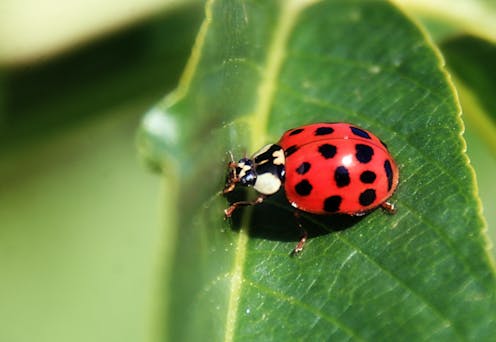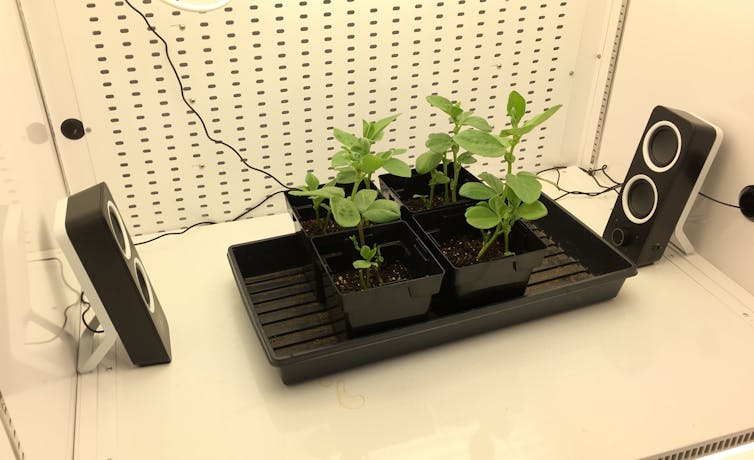Rock 'n' roll is noise pollution – with ecological implications that can spread through a food web
An AC/DC-loving biologist tests the band's 1980 assertion that "rock 'n' roll ain't noise pollution." Turns out it can be – and the negative effects of noise can ripple through an ecosystem.

Despite being one of the best-selling albums of all time, ideology from AC/DC’s “Back in Black” album has gone unchallenged for nearly 40 years. The album’s closing track posited a testable hypothesis, asserting with rock-star confidence that “Rock ‘n’ roll ain’t noise pollution.” Opinions may vary from person to person, but little scientific evidence has been evaluated to determine if rock music is noise pollution … until now.
My research group recently tested the “AC/DC hypothesis.” Sadly, we report that, at least in some situations, rock ‘n’ roll in fact is noise pollution.
OK, yes, our experiment may sound silly or frivolous. But our hope is to focus a little more attention on how sounds – whether Angus Young’s guitar licks or the steady drone from a busy highway – can affect ecosystems. Our work demonstrates that the effects of noise pollution are not restricted just to the animals directly affected by the sounds, but can alter their behaviors and interactions with other animals and plants, spreading the effects throughout an ecosystem.
Noise and nature
Noise pollution has been recognized as an increasing threat for wildlife. For instance, scientists have shown that the sounds of mining can affect deer behavior. Noise from ocean drilling affects marine life. And sounds from recreational vehicles are a particular concern in natural places – spawning an industry of quieter electric alternatives.
Most existing studies focus largely on the direct effects of noise – an animal hears the noise in its environment and is affected. But of course, animals don’t live in isolation. They’re embedded within a tangle of food web interactions with other species. So by affecting even one species, noise pollution – or any other environmental change – may generate indirect effects that spread from individual to individual, and eventually may affect entire communities.
Studying noise pollution and its cascading indirect effects is difficult, especially on large free-roaming animals. To test these interactions, my research group will often scale-down our experiments and use smaller model systems.
Specifically, we study lady beetles, including Harmonia axyridis, the multi-colored Asian lady beetle. Unknown to many, lady beetles are among the most important predators of agricultural pests such as soybean aphids. By voraciously consuming aphids in soybean fields, lady beetles provide natural biological control of pests and minimize the amount of pesticides needed on crops. Lady beetles provide an important ecosystem service – anything that disrupts their ability to attack aphids could be perceived as having a negative effect on society.

Firing up the hi-fi in the ecology lab
With the help of colleagues – and fellow AC/DC fans – Vince Klink and Marcus Lashley, my team of undergraduate and graduate students sought to determine if noise pollution would decrease lady beetle effectiveness at controlling aphids. Further, we suspected that reducing predation rates on aphids would allow the pest population to explode, which would in turn reduce soybean yield.
First we wanted to figure out what sounds affected lady beetle feeding rates. We placed lady beetle larvae within small enclosures with a known number of aphids to eat, and allowed them to forage either in silence or under loud conditions. We played sounds through computer speakers at maximum volume: 95-100 decibels, approximately equal to a lawn mower or outboard motor.
In addition to AC/DC, we queued up one of our favorite country music albums – “Wanted! The Outlaws” featuring Willie Nelson, Waylon Jennings and others. We DJ’d a mix of rock music, including Lynyrd Skynyrd, Guns ‘n’ Roses, The Supersuckers, the British folk band Warblefly, and a mix of city sounds such as jackhammers, car horns, and so on.
Our results were good news for country and folk fans – lady beetles agreed that those songs were not noise pollution and continued to attack aphids with the same vigor when serenaded by these genres as they did in silence. However, lady beetles were not fans of AC/DC, the rock mix or city noises, even when played at the same volume as the country and folk treatments. In fact, listening to the “Back in Black” album cut the amount of aphids being eaten during a 16 to 18 hour period almost in half.
At least according to lady beetles, it seemed that rock ‘n’ roll was noise pollution and indirectly benefited agricultural pests. But could it have an effect on soybean plants?
Many researchers have investigated how music affects plant growth with mixed results. However, when we blasted soybean plants with two weeks of nonstop “Back in Black,” we didn’t see any effect on growth. Similarly, we found no effect of continuous AC/DC on pest abundance when we grew aphids on plants without their predators.
But we were interested in whether there was an interactive effect of rock music and predators on pest and plants. So for two weeks, we watched lady beetles attack aphids, while aphids reproduced and plants grew.
When the plants were grown without music, the predators reduced aphid density to nearly zero. As a consequence, the plants grew strong and healthy in the absence of their pest. In contrast, when plants were grown with “Back in Black” blaring, the lady beetles did not control aphids and the pests’ population size was more than 40 times larger than in the silent condition – from an average of about 4 aphids per plant to more than 180. As a consequences of high pest abundance, the plants in music treatments were 25 percent smaller.

Cascading effects of noise pollution
While others have shown that noise pollution can have direct effects on organisms and alter their predation rates, our study uniquely demonstrates that these effects can cascade throughout a food web.
We also showed that insects are affected by noise pollution, too. Most previous work in this area focused on large, “sexy” megafauna. But insects provide many ecosystem services that are essential for the healthy functioning of our planet. Disrupting insect behaviors such as pollination or predation can have drastic consequences.
Finally, our work empirically evaluated the AC/DC hypothesis for the first time since its inception in 1980. As fans of AC/DC and rock music, we sadly must disagree with the band and concede that rock ‘n’ roll is noise pollution, at least for lady beetles. Of course, rock music is not really a threat to ecosystems. But because loud music is similar to other real-world instances of noise pollution such as the hum of snowmobiles and the buzz of drones overhead, our results serve as a proof-of-concept that sound pollution can have pervasive effects throughout an ecosystem.
What about AC/DC’s other hypothesis, that “rock n roll ain’t gonna die?” As rock lovers, we’re happy to report there’s no evidence to contradict that one.
Brandon Barton does not work for, consult, own shares in or receive funding from any company or organisation that would benefit from this article, and has disclosed no relevant affiliations beyond their academic appointment.
Read These Next
Drones, physics and rats: Studies show how the people of Rapa Nui made and moved the giant statues –
The mysteries of Easter Island, subjects of speculation for centuries, yield to scientific inquiry.
As US hunger rises, Trump administration’s ‘efficiency’ goals cause massive food waste
Despite the administration’s claim of streamlining the government to make its operations more efficient,…
A year on, the Israeli-Lebanese ceasefire looks increasingly fragile − could a return to cyclical vi
Since the start of the truce on Nov. 27, 2024, there have been thousands of Israeli violations inside…





